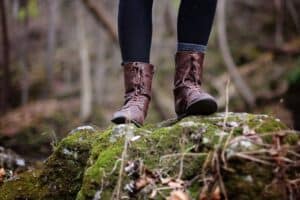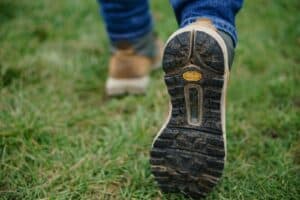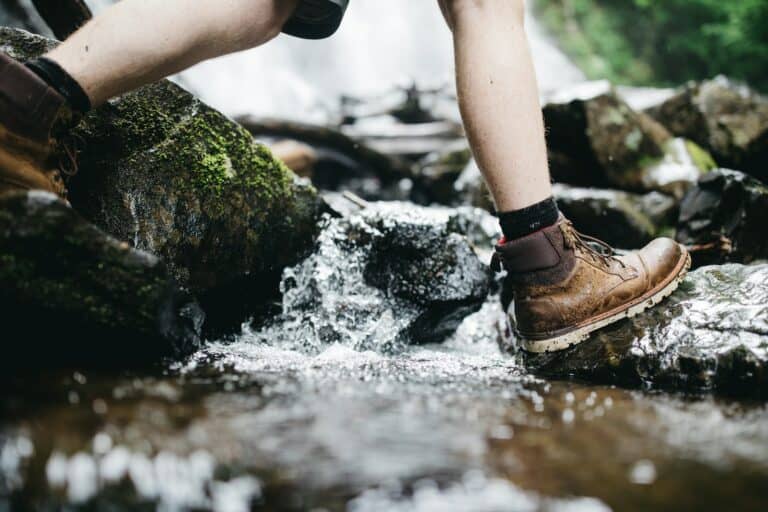Ever wondered, should hiking boots be tight? You’re not alone. It’s a common question I get from both newbie and seasoned hikers. The answer isn’t as straightforward as you might think. There’s a fine line between a snug fit and a circulation-cutting squeeze when it comes to hiking boots.
Factors to Consider When Choosing Hiking Boots

Selecting the right hiking boots isn’t as straightforward as picking a shoe size. It’s a choice influenced by various aspects including hiking style, terrain, weight of the backpack, and personal comfort.
Foot size changes: Throughout a single day, your foot’s dimensions can fluctify due to a variety of reasons – weather, hydration levels, or even the time of day. I’d recommend trying on boots in the afternoon when your feet have expanded to their maximum size. This will help you avoid buying boots that are overly tight and uncomfortable during the trek.
Socks matter: It’s not just about the boots; your choice in hiking socks can greatly impact the fit. Thick, thermal socks can make your boots feel tighter while thin, breathable socks give a looser feel. I’d suggest testing your boots with the same kind of socks you plan to use during your hikes.
Ankle Support: Hiking boots come in different styles: low-cut, mid-cut, and high-cut. Each has its own perks in terms of comfort and ankle support. Remember, while high-cut boots provide better ankle support, they might be tighter and a bit less comfortable for some hikers.
Break-in Period: Lastly, keep in mind that new boots have a break-in period – they’ll gradually form to your feet over time. Starting with a slightly more comfortable, slightly loose fit will ensure your boots don’t become too tight after the break-in period.
Take your time choosing your hiking boots. Consider all these factors and decide which is most significant for your hiking needs. Remember, comfort is key when it comes to hiking boots. Because once you’re out there on the trail, there’s no turning back.
The Importance of a Good Fit
Let me drill it into your head right now–the right fit can make or break your hiking experience. Getting a good fit is about more than just comfort; it’s integral for safety on the trails, and here’s why.
Injury Prevention
Incorrectly fitted boots could lead to discomfort or worse, foot injuries. Ill-fitting hiking boots are a primary cause of blisters, a known hiking menace that can make every step tortuous. But that’s not all. Shoes that are too loose could lead to twisted ankles or lost footing – serious dangers when trekking on uneven terrains.
Efficiency on the Trails
A well-fitted pair of boots will give you more certainty and stability on the trail. You’ll be less likely to hesitate on those steeper inclines because you trust your footwear and your steps are sure and uncompromised. This can allow more efficient and enjoyable hiking.
Long-term Foot Health
Let’s not forget the long-term impact of constantly wearing ill-fitted shoes. Consistently forcing your feet into the wrong size can lead to painful conditions like plantar fasciitis or bunions. You might not only ruin your hike, but also your overall foot health.
Getting the fit right isn’t always straightforward. You need to account for things like foot swelling, or the added pressure of a heavy backpack. It’s always worth getting professionally fitted if you can. And remember, it’s not just about your shoe size. Your foot’s width, arch height, and even its volume can dramatically affect fit.
Hiking boots should feel snug without being too tight–not easy to nail but trust me, it’s worth the extra effort. This sweet spot of boot fitting must be your ultimate goal when choosing hiking boots. Delaying or skimping on this process might end up costing you more in the long run.
Comfort isn’t a luxury in hiking–it’s essential. But it’s not only about feeling nice. Ensuring a proper fit helps to protect your feet, improve your efficiency, and maintain your foot health in the long run.
How Tight Is Too Tight?

Determining how tight is too tight when it comes to hiking boots can be a bit tricky. You don’t want your boots fitting like a pair of ballet slippers. At the same time, they shouldn’t feel like they’re about to fall off your feet. There’s a sweet spot in between where your hiking boots should ideally rest.
Your boots should feel snug but not constrictive. Bear in mind that the overall fit is what matters, not just the tightness around your foot. The fit needs to be even and comfortable throughout, from heel to toe.
Sometimes, it can be tempting to pick a tighter fit hoping the boots will stretch out with time. But that’s a common mistake many hikers make. Leather boots may give a bit over time, but this shouldn’t be your strategy for achieving the perfect fit. The boots should feel right from the first wear.
When trying on new hiking boots, always wear your hiking socks. They contribute considerable bulk and have a significant influence on the final fit. The boots may feel fine with everyday socks but might be too tight or uncomfortable with thicker hiking socks on.
Please don’t forget about foot swelling. After a day of hiking, your feet will likely puff up a bit, especially under the pressure of a heavy backpack. This is an important reason why the boots shouldn’t be too tight at the start.
In short, a well-fitting pair of hiking boots should feel snug but comfortable right out of the box. There should not be any pinching, rubbing, or discomfort when wearing them. Remember, there’s no universal answer to the question, “how tight is too tight for hiking boots?” It’ll vary from person to person, based on foot shape, size, and preference. Every hiker should aim for a good, comfortable fit that offers stability and suffices in providing safety on the trails.
Signs That Your Boots are Too Tight
After assessing the fine balance between snugness and comfort, you might be thinking, “how do I know if my hiking boots are too tight?” Here’s the deal. It’s critical to acknowledge the signs that your boots are indeed a little too snug for comfort.
Numbness or Tingling Sensations is one of the foremost signs. If I notice a tinkling feeling in my toes, especially during or after a hike, that’s a sign of uncomfortably tight boots. My feet are essentially signaling to me that they need more space to breathe.
Another sign is Swelling or Blisters. If after a hike, I find that my feet are swelling or blistered, particularly around the edges, it’s likely that my hiking boots are too tight. The constant rubbing paves the way for skin irritations or worse, blisters. That’s a clear thumbs down for both my comfort and foot health.
Pain or Discomfort is a big red flag. Any constant pain or discomfort while walking or hiking suggests that my boots don’t fit well. Whether it’s a constant pressure grinding against my toes, or a persistent pain in the balls of my feet, I should not ignore them. It’s a direct signal that my boots are too tight.
Note this – tightness in specific regions, such as the heel or toes, can still be an issue. It’s not just the overall tightness, but also Localized Tightness that needs vigilance. If my heel is slipping or my toes are getting squished, my boot fit needs reconsideration.
A Difficulty in Moving Your Toes doesn’t bode well either. If I’m finding it tough to wiggle my toes around, that’s a telltale sign my boots are too constricting.
Remember, recognizing these signs can help spare you discomfort and longer-term health issues. It’s always smart to ensure that your boots are fitting well before going on a hiking adventure. Each small discomfort can turn into a significant obstacle on the trails. Focus on the care of your feet by ensuring your hiking boots provide the right blend of snugness and space.
The Benefits of a Snug Fit

A snug fit in hiking boots presents a world of benefits. One that’s top of my list is increased stability. Hiking boots that fit well tend to offer much needed firmness and support while on long or challenging trails. Stability translates to better balance and reduces the risk associated with potential ankle twists or sprains.
The second not-to-be-forgotten advantage is the prevention of blisters. Remember, a snug fit means your foot isn’t sliding around in your boot, reducing friction, which is the main culprit behind those painful blisters. Nobody wants to halt or entirely end their hiking adventure due to unwelcome blisters.
Lastly, a snug fit brings about improved trekking efficiency. With boots that fit perfectly, you’ll find your strides feel sturdier and more secure. No more pausing on the trail to adjust loose boots, and no wasted energy compensating for an ill-fitting pair. Effortless strides are the name of the game with a snug-fitting hiking boot.
However, it’s crucial to distinguish snug from tight. Tight boots can cause discomfort and harm, like reduced circulation, whereas a snug boot will feel secure and supportive without feeling too tight or restrictive. When trying on hiking boots, be sure to wear the same type of socks you’ll be wearing on the trail, and also simulate hiking conditions by walking around the store with a loaded backpack.
If you’re facing issues pinpointing the ideal snug fit, don’t shy away from seeking professional assistance. Getting your feet measured by a professional can be helpful and ensure that you get the best fit for your comfort and safety. So, the next time you’re out shopping for new hiking boots, remember those benefits – increased stability, prevention of blisters, and improved trekking efficiency – and you’re halfway there to scoring that perfect pair.
Conclusion: Should Hiking Boots Be Tight
So, there you have it. It’s clear that while a snug fit is key for hiking boots, they shouldn’t be too tight. Remember, you’re looking for a balance between comfort and stability. Too tight, and you’ll be dealing with discomfort and potential injury. Just snug enough, and you’ll reap the benefits of increased stability, blister prevention, and improved trekking efficiency.
Don’t forget the importance of trying on boots with the same type of socks you’ll be wearing on your hikes, and simulating hiking conditions as much as possible. And if you’re unsure, seek professional help. They’ll be able to measure your feet and provide advice on the best fit for you.
So when you’re next in the market for hiking boots, keep these points in mind. Your feet, and your hiking experience, will thank you.

